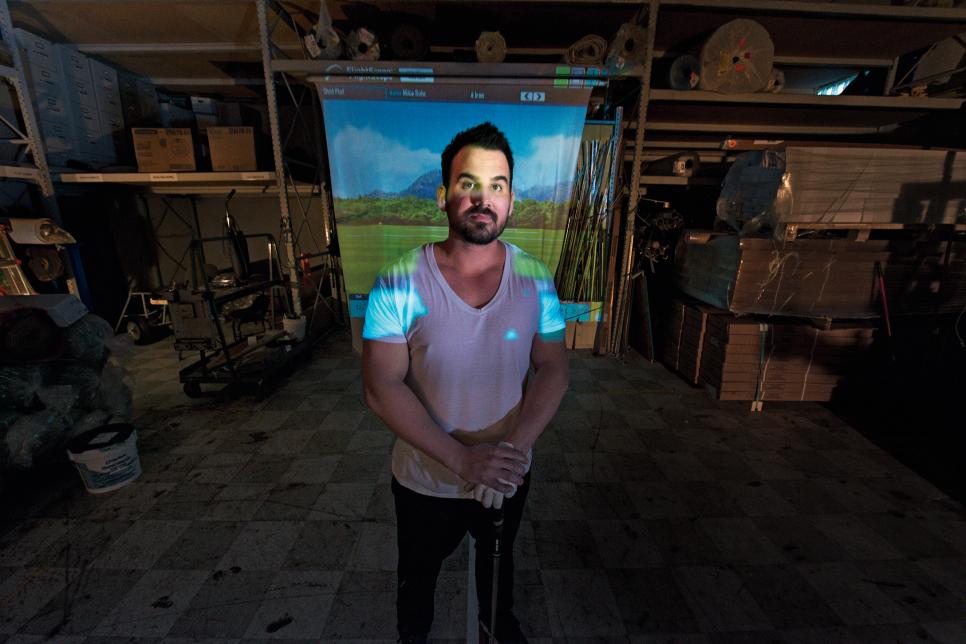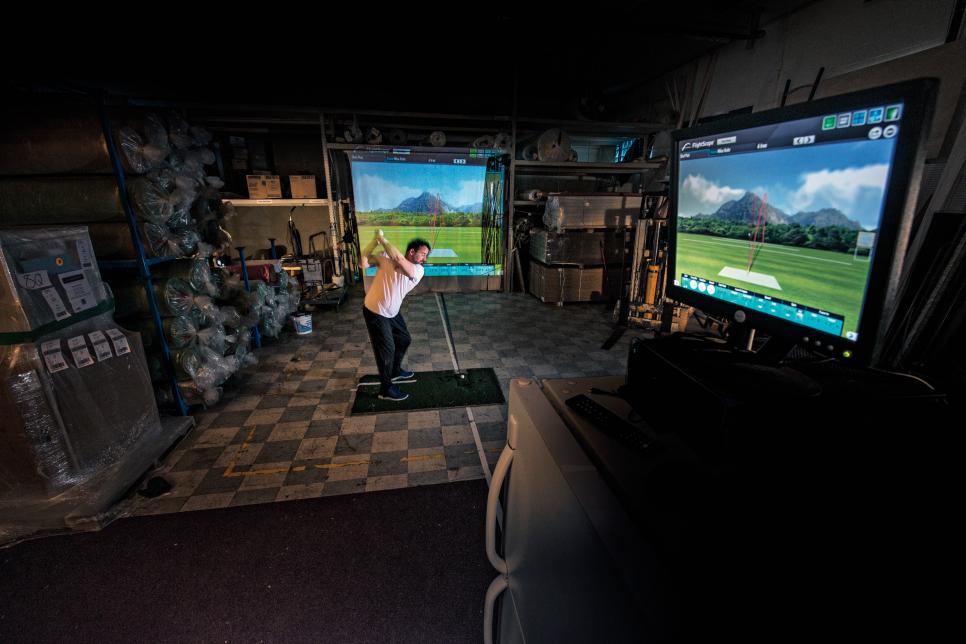One of the first real scenes from Tiger Woods' 2016 comeback was of the superstar in shorts, hitting a careful 9-iron into a wall-height screen on a fancy in-home simulator.
It isn't hard to imagine that a $50-million mansion would have the finest technology (and finishes) money can buy, but you don't have to have a nine-figure income to work on your game in the comfort of your basement or garage.
Mike Rohr and Kyle Morris each did it from scratch—Rohr in unused warehouse space at his company outside Detroit, and Morris for his teaching studio in Dublin, Ohio. Depending on the level of technology you want, a complete build-out with turf, netting, screen, computer, software and projector will run you $3,000 at the low end and upward of $50,000 if you check all the option boxes.
Rohr's project was down and dirty. Taking advantage of the space at his carpet business (and his experience installing floors and as a former instructor at TPC Scottsdale), he sourced and built everything for the hitting area for less than $500. He bought a second-hand FlightScope Kudu indoor radar tracking system for $1,700, and a screen, projector and an ordinary PC for another $750.
The setup is less than elegant, with the projector and computer resting on an employee refrigerator, but Rohr happily bashes balls through the cold Michigan winters. He even used one of his carpeting tricks to get a more realistic experience. "I removed the center section of the hitting mat and added a small cut-out of turf," says Rohr, who posts videos of his muscle-shirted 108-miles-per-hour 8-irons on Facebook and Instagram. "It flies away like a divot, which reduces the impact on your joints and gives you more realistic numbers on the radar."
Morris started his project with far less handyman credentials, but he had a bigger budget and a more ambitious goal: build an enclosed simulator space from the bare studs for his boutique golf-instruction studio. It took him two months and about $35,000—which includes the cost of a top-of-the-line $25,000 TrackMan radar system. "My expertise walking in? I could screw in a light bulb," says Morris, whose finished product can be found at The Golf Room in Dublin. "I'm no Bob Vila, but my wife is super handy. She architected out how it would look, and I put it together piece by piece."
To build a viable simulator that can accommodate the full bag, you need at least 15 feet of run from the tee area to the screen, 10 feet of width and 10-foot high ceilings. The framework for the screen isn't complicated to make, and the turf and netting for the floors and walls is relatively cheap. "Really, all you need are three pieces of angle iron bolted to a stud, a screen, a mat, a simulator and a projector, a computer and an HDMI splitter," Morris says. "The expense comes with upgrading the technology. If you're going to do an indoor simulator, why would you use something that isn't accurate? What's the point? For a decent player, there's a big difference between hitting a 7-iron 145 and 152."
Morris' polished space looks like a high-end display at the PGA Merchandise Show, with mood lighting and nice chairs. Meticulous spreadsheet work tells him he saved $15,000 off TrackMan's $50,000 sticker price for a turnkey studio build-out. The learning curve was such that when Morris built another simulator bay next door, he cut a week off the assembly time. "It's kind of like having that second kid," Morris says. "You know what to expect the next time around."
One common mistake? Failing to take into account what happens when you don't catch shots exactly, um, flush. You're going to want carpet or padding off to the sides to keep shanks from ricocheting off your head.
Rohr and Morris say there's plenty of ground between a bare-bones setup—built around a second-hand radar unit or a $2,000 photo-based unit like Sky Trak— and a professional-grade rig for anybody to find the right combination of technology and economy. "If I was putting one in my house, I wouldn't need some of the bells and whistles, but if you're already committing to spend $25,000 on a TrackMan, what's another $1,000 or $1,500 to get a nicer screen or a higher-quality hitting mat?" says Morris, who added a matching simulator in the bay next to his first build. "You could also get a Foresight Sports GC2 launch monitor—which you could also take outside—and have a nice setup for around $8,000."
If the blizzard of simulator, screen, projector and mat options make your head hurt, you can leave the decisions to the experts. Full Swing Golf sells a do-it-yourself version of its popular S2 simulator that comes with everything you need in one box. The company says it would take two reasonably handy people two days to put the package together following the video instructions. What does "reasonably handy" mean? That you'd be comfortable installing a powered garage-door opener.
The S2 starts at $19,900, or you could spend $50,000 or more to upgrade to the S8 model Woods and Jordan Spieth have in their homes—and see all of your shanks and foozles in high-definition.
Convenience does have a price.

Dom Furore / Golf Digest
▶ Do It Yourself: How To Build Your Own Putting Green
For homeowners desiring to pack more golf into their lives—not add a chore—a synthetic-turf green is the way to go.
By Max Adler
▶ Do It Yourself: How To Build Your Own Clubs
The only reward greater than distance is knowledge.
By Mike Stachura
▶ Do It Yourself: Swings
Even instructors agree, the best players are often self-taught.
By Joel Beall
▶ Do It Yourself: How To Make A Training Aid, Sunday Bag, And Headcover
By Keely Levins
